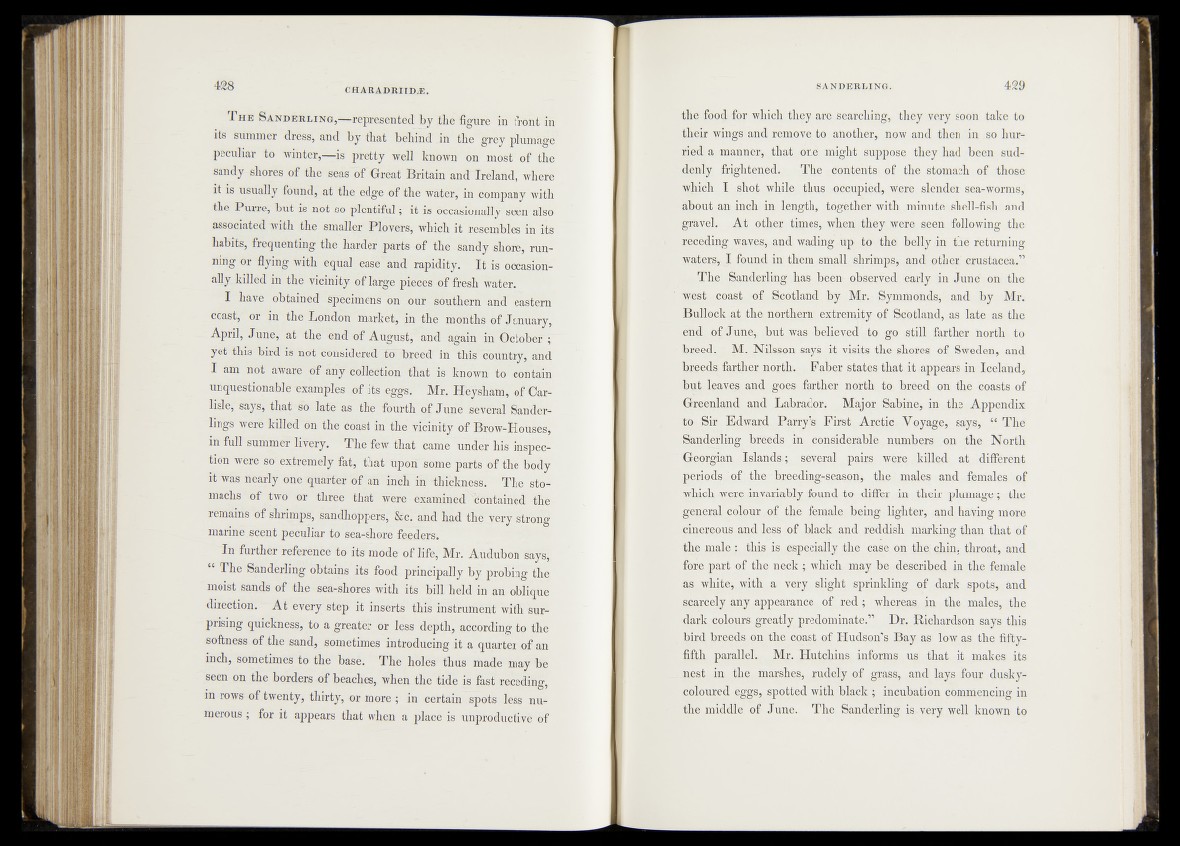
T h e SANDERLraà,^a«piæséîîted by the figure in front in
its summer dï-ess, and by that behind in th e ^ ê ÿ phimk|è
peculiar to winter,—is pretty well known on moSlT 0/ tlie
sandy -shores of the sfeàs o f Gréât Britain and Ireland, where
it xg usually found, at the edge of the water^ff uompany with
the Purre, but is not so plentiful ; it is '’öcëasionaHy ^teh
assodatëd'with the smaller Plpy%s, which it resembles^ its
habits, frequenting the harder parts of the J ln d y shore, running
or flying with eq u ah& sew d rapidity:' ^ I t is l )@ ^ -
allyJrilled in the’v ic in it^ |^ f l^ ^ ^ ^ g s " ( f f^ e s h ^ ^ ^ .
I have obtained specimens bn ouf-‘southern |n0[ ’eastern
cóastf or in the London marketen the months oftó iu a ry ,
April, June, at the end of August^* in 0 c t® (if;
ÿet this birdldrnot considered* to^fireed in th^N^ntter^fend
I am not aware of ahy coheetion that is
unquestionablenxamples of Mr. B ë y& ^ ;::of Carlisle,
says, that so. late as the* fourth of June l^&'I^Sauàer-
lings were killed on the coast m the^^cilnty ^FBrow-Iî^p^ 3
in fu lb sum m ^T if^ , TheTew that came under
tio’n were so extremëly fat, that upofsoïne paH'spf tM^ody
it was neaAy" one-quarter of fan inch inH h ic ^ i^ f The stomachs
o f two or three that were 'examined^^StliM^d’ Ifrt -
remains of shrimps, 'saüdhópperfflp. and had t® e r f% ro n g
marine.scent peculiar tp sea-shore feeders.
In further reference^) its mode of life, Mr. Audubon mfSf
“ The Sanderling obtains its food principally by probing â>e
moist sands of the sea-shores with its bill: held in an oblique
direction. _ At everystep it inserts this instrumérît with surprising'
quickness, to a greater or less depth, according to the
softness of the sand, sometimes introducing it a quarter of an
inch, sometimes to the basé. The holes thus made may be
Seen on the borders of beaches, when the tide is fast receding,
in rows of twenty, thirty, or more ; in certain spots less numerous
; for it appears that when a place is unproductive of
theVffdp^. for which they are searching, they very soon take to
their Wings^a^d re^p-yC} to another, now and then in so hurried
a*manner,-,lhat ond might Suppose they had been suddenly
frightened^ The < contents- of the stomach of those
which I shot while thus occupied, were slender sea-worms,
about an inch in-xtongth, Ipggther with minuteishell-fish and
gravel. wfien, they were seen following the
receding ^ayeskand wading' up to th% belly in the returning
Wafers*J fpmdrin them,small shrimps, and other' Crustacea.”
The Sanderling has been: observed, early in June on the
coast of: f J u t l a n d , fey Mr. Sympionds, and by Mr.
Builpck at th^np^hpru^e^-tseinily of Scotland, as Jul?. as the
en#t.i>^/June; ; was believed' to go still farther north to
fe^eed. ; M. Nilsspu it visits the shores of Sweden, and
breeds farther nos^.*^ Faber states,,that it appears in Iceland,
j j ffib leaves cmd^gops- farther north to breed on the coasts of
Gggeqligpfl, and Labrador. Majo^Sahjne, in the Appendix'
to Sir Edward Parry’s First Arctic- Voyage, says, “ The
Sanderling| hfepds in ^fpnsiderable numbers, on the '-North
Bjeprgian^,Islands; several pairs were killed at different
peripds^ of; therbreediug-season, the males and females' of
whiclwwere invariably to--differ in their plumage; the
gencr^kcqjour of the femalej,bping,lighter, and having more
.cinerepuS^and-le§s of black and reddish marking than that of
the maleytegthis is especially the case on the, chin, throat, and
fore part of the neck ; which may be described in the female
as white, with a very, slight sprinkling of dark spots, and
scarcely any appearance of; red ; where.as,. in the males, the
dark colours greatly predominate.” . Dr. Riehardson says this
bird breeds on the coast of Hudson’s Bay as low as the fifty-
fifth parallel. Mr. Hutchins, informs us that it makes its
nest in tln^ marshes, rudely of grass, and lays four dusky-
coloured eggs, spotted with black ; incubation commencing in
the middle of June. The Sanderling is-very well known to